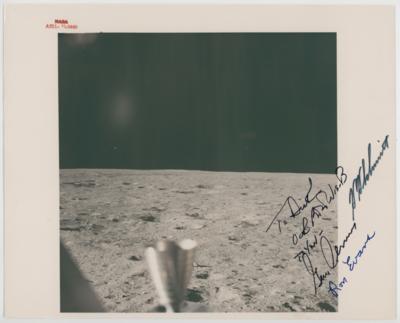Neil Armstrong (Apollo 11)
The first photograph taken by humans from the surface of another world, 16-24 July 1969
Vintage chromogenic print on fiber-based paper, printed 1969, numbered "NASA AS11-37-5449" (NASA MSC) in red in top margin, with "A KODAK PAPER" watermark on verso, signed and inscribed by the crew of Apollo 17 and last men on the Moon Eugene Cernan, Harrison Schmitt and Ronald Evans to NASA legend of photography Richard "Dick" Underwood, with a certificate of authenticity of Robert Underwood, son of "Dick Underwood, 20,3 x 25,4 cm
This is the very first frame (from the first panoramic sequence) taken on the Moon just after landing by Neil Armstrong from his LM Commander window showing the surface horizon at Tranquility Base seen towards the left/south with a thruster of the LM Eagle on the foreground.
“In my view, the emotional moment was the landing. That was human contact with the Moon, the landing.”
Neil Armstrong (Chaikin, Voices, p. 58).
As stated by Richard Underwood, NASA chief of photography and the astronauts’ instructor, to Eugene Cernan:
“Gene: This photograph has never been published. I can’t understand just why. For it is one of the most astounding photographs ever recorded in all of human history. It is the very FIRST photograph ever taken by a human being while on the surface of the Moon…
(NASA memo of Richard “Dick” Underwood to Capt. Gene Cernan, 21 October 1972)
Neil Armstrong and Buzz Aldrin had two Hasselblad cameras inside the LM.
One called the IntraVehicular Camera (IVA): the camera body was black and not intended for use outside during the EVA.
The other camera for use outside on the lunar surface (Hasselblad 500EL Data Camera), called the ExtraVehicular Camera (EVA), which had a silver-colored finish to prevent overheating. It also had a reseau plate, so images taken with it did show a grid of crosses. The EVA camera had a wide-angle 60mm Zeiss-Biogon lens.
Expert: Mag. Eva Königseder
 Mag. Eva Königseder
Mag. Eva Königseder
+43-1-515 60-421
eva.koenigseder@dorotheum.at
27.09.2023 - 15:48
- Dosažená cena: **
-
EUR 4.940,-
- Odhadní cena:
-
EUR 6.000,- do EUR 8.000,-
- Vyvolávací cena:
-
EUR 3.000,-
Neil Armstrong (Apollo 11)
The first photograph taken by humans from the surface of another world, 16-24 July 1969
Vintage chromogenic print on fiber-based paper, printed 1969, numbered "NASA AS11-37-5449" (NASA MSC) in red in top margin, with "A KODAK PAPER" watermark on verso, signed and inscribed by the crew of Apollo 17 and last men on the Moon Eugene Cernan, Harrison Schmitt and Ronald Evans to NASA legend of photography Richard "Dick" Underwood, with a certificate of authenticity of Robert Underwood, son of "Dick Underwood, 20,3 x 25,4 cm
This is the very first frame (from the first panoramic sequence) taken on the Moon just after landing by Neil Armstrong from his LM Commander window showing the surface horizon at Tranquility Base seen towards the left/south with a thruster of the LM Eagle on the foreground.
“In my view, the emotional moment was the landing. That was human contact with the Moon, the landing.”
Neil Armstrong (Chaikin, Voices, p. 58).
As stated by Richard Underwood, NASA chief of photography and the astronauts’ instructor, to Eugene Cernan:
“Gene: This photograph has never been published. I can’t understand just why. For it is one of the most astounding photographs ever recorded in all of human history. It is the very FIRST photograph ever taken by a human being while on the surface of the Moon…
(NASA memo of Richard “Dick” Underwood to Capt. Gene Cernan, 21 October 1972)
Neil Armstrong and Buzz Aldrin had two Hasselblad cameras inside the LM.
One called the IntraVehicular Camera (IVA): the camera body was black and not intended for use outside during the EVA.
The other camera for use outside on the lunar surface (Hasselblad 500EL Data Camera), called the ExtraVehicular Camera (EVA), which had a silver-colored finish to prevent overheating. It also had a reseau plate, so images taken with it did show a grid of crosses. The EVA camera had a wide-angle 60mm Zeiss-Biogon lens.
Expert: Mag. Eva Königseder
 Mag. Eva Königseder
Mag. Eva Königseder
+43-1-515 60-421
eva.koenigseder@dorotheum.at
|
Horká linka kupujících
Po-Pá: 10.00 - 17.00
kundendienst@dorotheum.at +43 1 515 60 200 |
| Aukce: | The Beauty of Space - Iconic Photographs of Early NASA Missions |
| Typ aukce: | Online aukce |
| Datum: | 27.09.2023 - 15:48 |
| Místo konání aukce: | Wien | Palais Dorotheum |
| Prohlídka: | Online |
** Kupní cena vč. poplatku kupujícího a DPH
Není již možné podávat příkazy ke koupi přes internet. Aukce se právě připravuje resp. byla již uskutečněna.
Všechny objekty umělce

